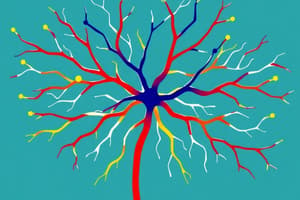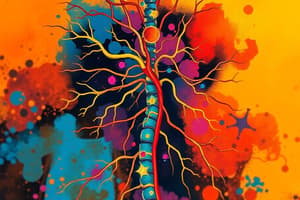Podcast
Questions and Answers
What is the resting membrane potential (RMP) value under normal conditions?
What is the resting membrane potential (RMP) value under normal conditions?
- -70 mV (correct)
- -50 mV
- -90 mV
- -30 mV
Which mechanism contributes to the negative charge inside the membrane during RMP?
Which mechanism contributes to the negative charge inside the membrane during RMP?
- Na+/K+ pump only
- Passive diffusion of K+ ions only
- Selective permeability of the membrane only
- Both Na+/K+ pump and selective permeability (correct)
Why is the resting membrane more permeable to K+ compared to Na+?
Why is the resting membrane more permeable to K+ compared to Na+?
- Na+ channels are more abundant than K+ channels
- K+ ions are larger and thus move easier through the membrane
- K+ channels remain open while Na+ channels are closed (correct)
- K+ channels are closed under resting conditions
What prevents Na+ from entering the cell during resting conditions?
What prevents Na+ from entering the cell during resting conditions?
What is the role of non-diffusible ions inside the cell in relation to RMP?
What is the role of non-diffusible ions inside the cell in relation to RMP?
What is the primary role of neurons in the nervous system?
What is the primary role of neurons in the nervous system?
Which part of a neuron is involved in receiving signals?
Which part of a neuron is involved in receiving signals?
What structure separates the presynaptic and postsynaptic neurons at a synapse?
What structure separates the presynaptic and postsynaptic neurons at a synapse?
Which type of synapse is considered the most common and least excitable?
Which type of synapse is considered the most common and least excitable?
What is a key property of neurons that allows them to respond to stimuli?
What is a key property of neurons that allows them to respond to stimuli?
What distinguishes chemical synapses from electrical synapses?
What distinguishes chemical synapses from electrical synapses?
How does the nerve impulse conduct itself within a neuron?
How does the nerve impulse conduct itself within a neuron?
Which of the following is NOT a function of neurons?
Which of the following is NOT a function of neurons?
What is defined as the minimal intensity of a current that can stimulate after a very long duration?
What is defined as the minimal intensity of a current that can stimulate after a very long duration?
Which type of stimuli is characterized by causing a response through a chemical reaction?
Which type of stimuli is characterized by causing a response through a chemical reaction?
What does the term 'chronaxia' specifically relate to in terms of stimulus?
What does the term 'chronaxia' specifically relate to in terms of stimulus?
Which factor primarily affects the response degree to stimuli based on how quickly the stimulus occurs?
Which factor primarily affects the response degree to stimuli based on how quickly the stimulus occurs?
How does the strength-duration curve illustrate the relationship between stimulus strength and required duration for excitation?
How does the strength-duration curve illustrate the relationship between stimulus strength and required duration for excitation?
In which context is diathermy most effectively applied?
In which context is diathermy most effectively applied?
Which type of current stimulation is associated with low intensity and prolonged application?
Which type of current stimulation is associated with low intensity and prolonged application?
Which of the following muscle types has the longest chronaxia and lowest excitability?
Which of the following muscle types has the longest chronaxia and lowest excitability?
Flashcards
Neuron
Neuron
The structural unit of the nervous system; a nerve cell that can generate and transmit signals (action potentials).
Dendrites
Dendrites
Branching extensions of a neuron that receive signals from other neurons.
Axons
Axons
Long, slender projections of a neuron that transmit signals to other neurons, muscles, or glands.
Synapse
Synapse
Signup and view all the flashcards
Neurotransmitters
Neurotransmitters
Signup and view all the flashcards
Gray Matter
Gray Matter
Signup and view all the flashcards
White Matter
White Matter
Signup and view all the flashcards
Action Potential
Action Potential
Signup and view all the flashcards
Stimulus
Stimulus
Signup and view all the flashcards
Types of Stimuli
Types of Stimuli
Signup and view all the flashcards
Rheobase
Rheobase
Signup and view all the flashcards
Strength-Duration Curve
Strength-Duration Curve
Signup and view all the flashcards
Utilization Time (U.T)
Utilization Time (U.T)
Signup and view all the flashcards
Chronaxia
Chronaxia
Signup and view all the flashcards
Excitability
Excitability
Signup and view all the flashcards
Faradic Current
Faradic Current
Signup and view all the flashcards
Resting Membrane Potential (RMP)
Resting Membrane Potential (RMP)
Signup and view all the flashcards
Na+/K+ pump
Na+/K+ pump
Signup and view all the flashcards
Selective membrane permeability
Selective membrane permeability
Signup and view all the flashcards
K+ permeability vs. Na+ permeability
K+ permeability vs. Na+ permeability
Signup and view all the flashcards
Hydration energy effect on ion permeability
Hydration energy effect on ion permeability
Signup and view all the flashcards
Study Notes
Nerve 1
- Nerve 1 is a topic presented by Dr. Neven Makram Aziz.
Neuron
- A neuron is the fundamental unit of the nervous system.
- Billions of nerve cells (neurons) make up the nervous system.
- Neurons are excitable cells, capable of generating and transmitting action potentials.
- Neurons resemble other body cells in their basic structure, containing cytoplasm, a nucleus, mitochondria, and other organelles enclosed by a cell membrane.
- Neurons also perform cellular functions like protein synthesis (by Nissl granules) and energy production (by mitochondria).
- Neuron cell bodies form the gray matter of the brain and spinal cord, grouped together as nuclei in the central nervous system (CNS).
- Neuron extensions (dendrites and axons) are usually referred to as nerve fibers.
- Nerve fibers form the white matter of the brain and spinal cord.
- Neurons possess specialized structures (synapses) and chemicals (neurotransmitters) for communication with each other.
Neuron Structure
- (Diagram on page 4 shows)
- Dendrites - branch-like structures that receive signals from other neurons.
- Nucleus - the control center of the cell.
- Cell body - contains the nucleus and other cellular components.
- Axon - a long, slender projection that transmits signals away from the cell body.
- Myelin sheath - insulating layer around some axons, increasing transmission speed.
- Axon ending - the terminal part of the axon where signals are passed to other cells.
Synapse
- A synapse is a contact point (without continuity) between presynaptic and postsynaptic neurons.
- Information transmission occurs across the synapse.
- A space (synaptic cleft) separates pre- and postsynaptic neurons at the synapse.
- Neurotransmitters are released into the synaptic cleft to transmit signals across the synapse.
Types of Synapses
- I. According to site:
- Between two neurons.
- Between a neuron and a muscle.
- Between a neuron and a gland.
- II. According to site of contact:
- Axodendritic (most common, least excitable).
- Axosomatic.
- Axonaxonic (least common, most excitable).
Electrical vs. Chemical Synapses
- Electrical synapses are rare.
- Electrical synapses utilize gap junctions for signal transmission (bi-directional).
- Chemical synapses are the most prevalent in the CNS.
- Chemical synapses use neurotransmitters for signal transmission (one-directional).
Properties of Neurons
- Excitability: the ability to respond to a stimulus.
- Conductivity: the ability to transmit a nerve impulse (active process).
- Neurons do not fatigue.
Stimulus
- A stimulus is any change in the environment that triggers a response in living tissue.
- Stimulus types include: electrical, chemical, mechanical, and thermal.
Factors Affecting Stimulus Response
- Rate of application: A sudden change elicits a stronger response than a slow change of the same intensity.
- Strength and duration of stimulus: strength-duration curve illustrates this relationship. A minimum stimulus strength (rheobase) is needed for a response; a minimum duration is also needed.
- Stronger stimuli require less time to elicit a response, and visa versa (within limits).
- There's a minimal stimulus intensity (rheobase) needed to elicit a response; lowering intensity below this doesn't elicit a response even with longer durations.
Threshold (Rheobase) Stimulus
- Threshold stimulus is the minimum intensity of current needed to stimulate a nerve, often of a very long duration (like galvanic current).
- Stimuli with lower intensities are called subthreshold.
- Two types of stimulation exist:
- Galvanic current: low intensity, long duration.
- Faradic current: high intensity, short duration.
Utilization Time (UT)
- UT is the longest time needed for a rheobase (threshold) stimulus to evoke a response.
Minimal Duration (t)
- There's a minimal duration (t) for a stimulus to be effective; reducing duration below t prevents stimulation regardless of intensity.
Chronaxia
- Chronaxia is the time required for a stimulus of double the rheobase intensity to evoke a response.
- Chronaxia is useful to compare the excitability of different tissues.
- Tissues with shorter chronaxia are more excitable.
Resting Membrane Potential (RMP)
- RMP is the potential difference between the inner and outer surfaces of the nerve membrane under normal conditions.
- RMP is approximately -70 mV, indicating a negative charge inside the nerve cell.
- RMP is measured using microelectrodes and an oscilloscope.
Causes of RMP
- Active Na+/K+ pump: The pump actively transports 3 sodium ions out of the cell and 2 potassium ions into the cell, maintaining a charge difference.
- Selective membrane permeability: The nerve cell membrane is significantly more permeable to potassium ions (K+) than to sodium ions(Na+). Because they open (or close) at different times, this establishes a membrane potential.
- Na+ channels are closed in resting conditions, while K+ channels are open. Na+ and K+ have different hydration energies, affecting their movement across the membrane.
- Non-diffusible ions (proteins, sulfate, phosphate) inside the cell contribute to the negative charge inside, along with the pump and selective permeability, contributing to overall negative potential.
Studying That Suits You
Use AI to generate personalized quizzes and flashcards to suit your learning preferences.




